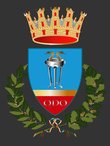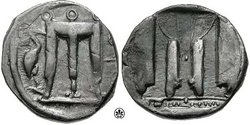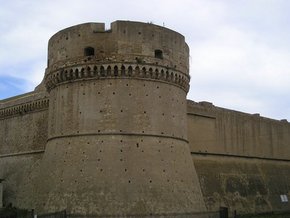Crotone
| Comune di Crotone | |
|---|---|
| Region | Calabria |
| Province | Crotone (KR) |
| Area cityproper | 179,800 |
| Population as of | December 31, 2004 |
| Population density | 60,157 |
| Population density metric | 333,7 |
| Timezone | CET, UTC+1 |
| Frazioni | Papanice, Apriglianello, Carpentieri, Cipolla, Farina, Gabella Grande, Iannello, Maiorano, Margherita |
| Telephone | 0962 |
| Postalcode | 88900 |
| Gentilic | Crotonesi |
| Saint | St. Denis |
| Day | October 9 |
| Mayor | Peppino Vallone (since May 2006) |
| Website | |
Crotone is a city in Calabria, southern Italy, on the Ionian Sea. Founded circa 710 BC as the Achaean colony of Croton (Greek: Κρότων; Modern Greek: Κρότωνας; Latin: Crotona), it was known as Cotrone from the Middle Ages until 1928, when its name was changed to Crotone. In 1994 it became the capital of the newly established Province of Crotone. As of December 31, 2004, its population was 60,517.
History
Croton was long one of the most flourishing cities of Magna Graecia. Its inhabitants were famous for their physical strength and for the simple sobriety of their lives. From 588 BC onwards, Croton produced many generations of victors in the Olympics and the other Panhellenic Games, the most famous of whom was Milo of Croton. According to Herodotus (3.131), the physicians of Croton were considered the foremost among the Greeks. Pythagoras founded his school, the Pythagoreans, at Croton circa 530 BC. Among his pupils were the early medical theorist Alcmaeon of Croton and the philosopher, mathematician, and astronomer Philolaus. The Pythagoreans acquired considerable influence with the supreme council of one thousand by which the city was ruled. Sybaris was the rival of Croton until 510 BC, when Croton sent an army of one hundred thousand men, commanded by the boxer Milo, against Sybaris and destroyed it. Shortly afterwards, however, an insurrection took place, by which the Pythagoreans were driven out and a democracy established.
In 480 BC, Croton sent a ship in support of the Greeks at the Battle of Salamis (Herodotus 8.47), but the victory of Locri and Rhegium over Croton in the same year marked the beginning of its decline. It was replaced by Heraclea as headquarters of the Italiote League. Dionysius, the tyrant of Syracuse, aiming at hegemony in Magna Graecia, captured Croton in 379 BC and held it for twelve years. Croton was then occupied by the Bruttii, with the exception of the citadel, in which the chief inhabitants had taken refuge; these, being unable to defend the place against a Carthaginian force, soon after surrendered, and were allowed to withdraw to Locri.
In 295 BC, Croton fell to another Syracusan tyrant, Agathocles. When Pyrrhus invaded Italy (280-278, 275 BC), Croton was still a considerable city, with twelve miles of walls, but after the Pyrrhic War, half the city was deserted (Livy 24.3). What was left of its population submitted to Rome in 277 BC. After the Battle of Cannae in the Second Punic War (216 BC), Croton revolted from Rome, and Hannibal made it his winter quarters for three years; it was not recaptured until 205 or 204 BC. In 194 BC, it became the site of a Roman colony. Little more is heard of it during the Republican and Imperial periods, though Petronius mentions the corrupt morals of its inhabitants.
Around 550, the city was unsuccessfully besieged by Totila, king of the Ostrogoths. At a later date it became a part of the Byzantine Empire. About 870 it was taken and sacked by the Saracens, who put to death the bishop and many people who had taken refuge in the cathedral. Over a hundred years later, Otto II, Holy Roman Emperor, mounted a campaign in southern Italy to drive them out and reduce the power of the Byzantines, but was defeated by a Kalbid army near Cotrone on July 13, 982. Later on Cotrone was conquered by the Normans. Thereafter it shared the fate of the Kingdom of Naples—including the period of Spanish rule of which the 16th-century castle of Charles V, overlooking modern Crotone, serves as a reminder—and its successor, the Kingdom of the Two Sicilies, which was conquered by the Kingdom of Sardinia in 1860 and incorporated into the new Kingdom of Italy in 1861.
Crotone's location between the ports of Taranto and Messina, as well as its proximity to a source of hydroelectric power, favored industrial development during the period between the two World Wars. In the 1930s its population doubled. Unfortunately, the two main employers, Pertusola Sud and Montedison, collapsed. By the late 1980s Crotone was in economic crisis, with many residents losing their jobs and leaving to find work elsewhere. In 1996, a flood dealt a further blow to the city's morale. Since that low point, the city has undergone urban renewal and risen in quality-of-life rankings.
Main sights
- the Cathedral, originally from the 9th-11th century, but largely rebuilt. It has a neo-classical façade, while the interior has a nave with two aisles, with Baroque decorations. Noteworthy are a baptismal font (12th century) and the Madonna di Capo Colonna, the icon of the Black Madonna which, according to the tradition, was brought from East in the first years of the Christian era.
- The 16th century Castle of Charles V. It houses the Town Museum, with findings excavated in the ancient site of Kroton. Notables are also the remnants of the walls, of the same century, and of various watchtowers.
- The ancient castle built on an island, with accessibility on foot limited to a narrow strip of land, is referred to as Le Castella.
Transportation
Crotone Airport (Sant'Anna Airport) is served by Air One and charter airlines. Crotone has also a railway station, although much of the tourism is served by the Salerno-Reggio Calabria highway. In recent time Crotone Port has been used by visitors on yacht charter cruising vacations.
Religion
According to local legend the Gospel was preached there by St. Dionysius the Areopagite. Its first known bishop was Flavianus, during whose episcopate occurred the siege of the city by Totila. Other bishops were: Theodosios (642); Petrus (680); Theotimus (790); and Nicephorus (870). Worthy of note are: Antonio Sebastiano Minturno (1565), a polished writer and poet; Juan López (1595), a Spanish Dominican; Tommaso dai Monti (1599), a Theatine famous for his zeal; and Niceforo Melisseno Comneno (1628), who had previously rendered signal service to the Holy See in the Orient and in France.
Museums
Croton hosts a national archaeological museum, a municipal museum, a municipal art gallery, and a provincial museum of contemporary art, as well as the Antiquarium di Torre Nao.
Sport
F.C. Crotone is a football club in Serie B.
External links


